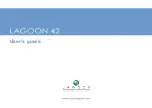
37
Deck
4
S
TABILITY
Breaking waves represent a serious danger for stability and for taking in water. Close the companionway
doors and hatches in heavy seas.
During sailing keep all the portholes, windows and doors closed.
- The stability is reduced when you add weight in the upper parts.
- Stability may be reduced when towing a boat or when heavy weights are lifted with the davits.
P
REVENTION
OF
MAN
OVERBOARD
Regularly check the guard-rails:
- With metal guard-rails, watch for corrosion particularly at connecting points.
- With synthetic guard-rails, change them as soon as they show signs of wear due to chafing or UV.
Areas forbidden when sailing:
- Aft quarterdeck.
- Roof.
M
OORING
LINES
A sufficient number of mooring lines suitably sized and suitable for the environment shall be on board for
mooring your boat.
- Always manoeuvre your boat using the engine.
- Make allowance for the current and wind when you handle your boat.
- Protect your boat to the highest degree with suitably sized fenders.
- Always keep the mooring ropes unfouled and stored away.
- Handle your boat at a reduced speed.
A
FTER
MOORING
- Protect the mooring lines against chafing with plastic sleeves.
- Make allowance for the variations in tides if need be.
D
ANGER
-Wear your life jacket.
-In heavy weather, wear your safety
harness and fasten yourself to the boat.
-When at sea close the guardrail side-
opening or openings.
-Do not try to stop the boat using a boat
hook or your foot, your hand or any other
part of the body.
W
ARNING
-The sudden closing of a locker due to a
gust of wind or movement of the boat
could result in injury.
A
DVICE
- R
ECOMMENDATION
-Close the deck hatches and portholes
before each trip (including the
companionway hatch in heavy weather).
Summary of Contents for OCEANIS 58
Page 1: ...OCEANIS 58 Code 119968 Index F Owner s Manual ...
Page 2: ......
Page 4: ......
Page 8: ......
Page 10: ......
Page 11: ...7 General specifications Technical specifications Certification Design category Your boat 1 ...
Page 16: ......
Page 24: ......
Page 30: ...26 USE OF THE MANUAL BILGE PUMP Location Operation Capacity 40 5 litre minute Safety ...
Page 32: ...28 USE STEERS FRANK OF HELP Sector access port Tiller in position Safety ...
Page 34: ......
Page 35: ...31 Hull Maintenance of the Hull Lifting 3 ...
Page 36: ...32 LIFTING Wetted area 80 m All versions Hull ...
Page 38: ......
Page 43: ...39 Deck Cockpit table 4 ...
Page 48: ......
Page 50: ......
Page 51: ...47 Steering system Steering Gear 5 ...
Page 52: ...48 STEERING GEAR Steering system ...
Page 53: ...49 Steering system Detail B Detail C 5 ...
Page 54: ...50 Detail D Steering system ...
Page 58: ......
Page 59: ...55 Rigging and sails Standing rigging Running rigging Winches Setting the sails Sails 6 ...
Page 74: ...70 AUTOMATIC REEFING SYSTEM Rigging and sails ...
Page 76: ......
Page 77: ...73 Interior Introduction Interior maintenance Maintenance of fabrics 7 ...
Page 78: ...74 INTRODUCTION Version 3 cabins Forepeak cabin Version 4 cabins Forepeak cabin Interior ...
Page 80: ...76 Suction cup system to lift floors SINK Open Closed Interior ...
Page 82: ......
Page 92: ......
Page 98: ......
Page 113: ...109 Electrical equipment AIR CONDITIONING SCHEMATIC DIAGRAM 9 ...
Page 118: ...114 HEATING SCHEMATIC DIAGRAM Electrical equipment ...
Page 120: ......
Page 126: ......
Page 128: ......
Page 130: ...ELECTRONIC TRANSDUCER LOCATION View interior View Outside Electrical equipment ...
Page 132: ......
Page 133: ...129 Engine General information Engine fitting 10 10 ...
Page 136: ...132 ENGINE FITTING Engine ...
Page 137: ...133 Engine 10 10 ...
Page 140: ......
Page 163: ...159 Launching Launching recommendations Stepping the mast 11 11 ...
Page 164: ...160 POSITION OF HOISTING CRADLE AND STRAPS Note Measurements are expressed in mm Launching ...
Page 166: ......
Page 168: ......
Page 169: ...165 Winter Storage Laying up Protection and maintenance 12 12 ...
Page 170: ......
Page 172: ......
















































